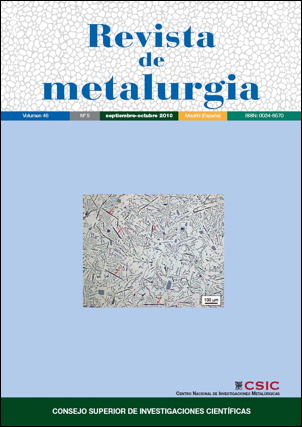Effect of cobalt on the corrosion behaviour of amorphous Fe-Co- Cr-B-Si alloys in dilute mineral acids
DOI:
https://doi.org/10.3989/revmetalm.0921Keywords:
Amorphous alloy, Corrosion, X-Ray diffraction, Alloying element, Passivation, MetalloidAbstract
The aim of this paper was to investigate the effect of increasing cobalt content on the corrosion resistance of the Fe- Co-Cr-B-Si alloys in dilute mineral acids. The corrosion rates in 0.5N HCl, 1N HCl and 1N H2SO4 significantly decrease with an increase in cobalt content. The alloys with a larger amount of cobalt can passivate spontaneously. The high corrosion resistance of the Fe-Co-Cr-B-Si alloys is also due to the formation of chromium -enriched passive film. Generally, the corrosion resistance of chromium –bearing alloy is improved by alloying with various metalloids but it is lowered by addition of boron and silicon. The corrosion behaviour of the amorphous Fe75-xCoxCr1B7Si17 alloys obtained by the melt-spinning technique was studied using gravimetric method. The best results were obtained with Fe65Co10Cr1B7Si17 alloy. The studied amorphous alloy ribbons exhibit not only excellent physical properties which are useful for many electric and magnetic applications: magnetic sensors, power transformers, high frequency transformers, etc., but also a very good corrosion resistance which extend their application domain.
Downloads
References
[1] M. Naka, K. Hashimoto and T. Masumoto, J. Japan Inst. Metals 38 (1974) 835-841.
[2] F.Dabosi,Colloque FORMATION, Societe Francaise deMetallurgie, INP, Toulouse, Tarbes, 1985.
[3] A. Lekatou,A.Marinou, P. Patsalas andM.A. Karakassides, J. Alloys Compd. 483 (2009) 514-518. doi:10.1016/j.jallcom.2008.07.217
[4] J. Jayaraj, K.B. Kim, H.S. Ahn and E. Fleury, Mater. Sci. Eng. A 449-451 (2007) 517-520. doi:10.1016/j.msea.2006.02.418
[5] S. Pang, C. Shek, T. Zhang, K. Asami and A. Inoue, Corros. Sci. 48 (2006) 625-633. doi:10.1016/j.corsci.2005.02.013
[6] I. Chattoraj, S. Baunack, M. Stoica and A. Gebert, Mater. Corros. 55 (2004) 36-42. doi:10.1002/maco.200303693
[7] R.S. Dutta and G.K. Dey, Bull. Mater. Sci. 26 (2003) 477. doi:10.1007/BF02707344
[8] J. Jayaraj, Y.C. Kim, K.B. Kim, H.K. Seok and E. Fleury, Sci. Technol. Adv. Mater. 6 (2005) 282-289. doi:10.1016/j.stam.2005.02.019
[9] D. Zander, B. Heisterkamp and I. Gallino, J.Alloys Compd. 434/435 (2007) 234-236. doi:10.1016/j.jallcom.2006.08.112
[10] R. Raicheff and V. Zaprianova, J. Univ. Chem. Tech. Metall. 44 (2009) 61-65.
[11] Z.L. Long, C.T. Chang, Y.H. Ding, Y. Shao, P. Zhang, B.L. Shen and A. Inoue, J. Non-Crys. Solids 354 (2008) 4609-4613.
[12] R. Zallen, The Physics of Amorphous Solids, John Wiley & Sons, 1998. doi:10.1002/9783527617968
[13] H. H. Liebermann, Rapidly solidified alloys: processes, structures, properties, applications,Marcel Dekker, New York, 1993.
[14] H.G. Kim, M. S. Kim and W. N. Myung, J. Korean Phys. Soc. 49 (2006) 1.630-1.634.
[15] C. Qin, W. Zhang, K. Asami, N. Ohtsu and A. Inoue, Acta Mater. 53 (2005) 3.903-3.911.
[16] T. Masumoto and K. Hashimoto, J. Phys. C 8 (1980) 894-900.
[17] F.F.Marzo, A.R. Pierna, J. Barranco, A. Lorenzo, J. Barroso, J.A. García y A. Pérez, J. Non-Crys. Solids 354 (2008) 5.169-5.171.
[18] E. Angelini, C. Antonione, M. Baricco, P. Bianco, F. Rosalbino and F. Zucchi, Werkst. Korros. 44 (1993) 98. doi:10.1002/maco.19930440307
[19] Z. Long, Y. Shao, G. Xie, P. Zhang, B. Shen and A. Inoue, J. Alloys Compd. 462 (2008) 52-59. doi:10.1016/j.jallcom.2007.07.117
[20] P. Marcus, Corrosion mechanisms in theory and practice, Marcel Dekker, New York, 2002. doi:10.1201/9780203909188
[21] A. Altube and A.R. Pierna, Electrochim. Acta 49 (2004) 303-311. doi:10.1016/j.electacta.2003.08.012
[22] E. Angelini, C. Antonione, M. Baricco, P. Bianco, F. Rosalbino and F. Zucchi, Metallurgia Italiana 83 (1991) 671.
[23] Z.L. Long, Y. Shao, X.H. Deng, Z.C. Zhang, Y. Jiang, P. Zhang, B.L. Shen and A. Inoue, Intermetallics 15 (2007) 1.453-1.458.
[24] E. Fleury, J. Jayaraj, Y.C. Kim, H.K. Seok and K.Y. Kim and K.B. Kim, J. Power Sources 159 (2006) 34-37. doi:10.1016/j.jpowsour.2006.04.119
[25] J. Jayaraj, Y.C. Kima, K.B. Kima, H.K. Seok and E. Fleury, J. Alloys Compd. 434/435 (2007) 237-239. doi:10.1016/j.jallcom.2006.08.288
[26] S. M. Gravano, S. Torchio, F. Mazza, E. Angelini and M. Baricco, Corros. Sci. 33 (1992) 1227. doi:10.1016/0010-938X(92)90132-M
[27] M. Fujiwara, K. Takanashi,M. Satou, A. Hasegawa, K. Abe, K. Kakiuchi and T. Furuya, J. Nucl. Mater. 329/333 (2004) 452-456. doi:10.1016/j.jnucmat.2004.04.090
[28] A.S. Hamada, L.P. Karjalainen,M.C. Somani, Mater. Sci. Eng. A 431 (2006) 211-217. doi:10.1016/j.msea.2006.05.138
[29] Y. S. Choi, J. J. Shim and J. G. Kim, J.Alloys Compd. 391 (2005) 162-169. doi:10.1016/j.jallcom.2004.07.081
[30] I. Solomon, PhD Thesis, University of Galati, 1998.
[31] M. Magrini and P. Matteazzi, J. Mater. Chem. Phys. 13 (1985) 71. doi:10.1016/0254-0584(85)90028-8
[32] A. Dhawan, S. Roychowdhury, P. K. De and S. K. Sharma, Bull. Mater. Sci. 26 (2003) 609. doi:10.1007/BF02704324
[33] V. Schroeder and R. O. Ritchie, ActaMaterialia 54 (2006) 1785. doi:10.1016/j.actamat.2005.12.006
[34] J. R. Scully, A. Geber and J. H. Payera, J.Mater. Res. 22 (2007) 302. doi:10.1557/jmr.2007.0051
Downloads
Published
How to Cite
Issue
Section
License
Copyright (c) 2010 Consejo Superior de Investigaciones Científicas (CSIC)

This work is licensed under a Creative Commons Attribution 4.0 International License.
© CSIC. Manuscripts published in both the printed and online versions of this Journal are the property of Consejo Superior de Investigaciones Científicas, and quoting this source is a requirement for any partial or full reproduction.All contents of this electronic edition, except where otherwise noted, are distributed under a “Creative Commons Attribution 4.0 International” (CC BY 4.0) License. You may read here the basic information and the legal text of the license. The indication of the CC BY 4.0 License must be expressly stated in this way when necessary.
Self-archiving in repositories, personal webpages or similar, of any version other than the published by the Editor, is not allowed.
















